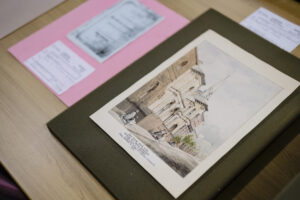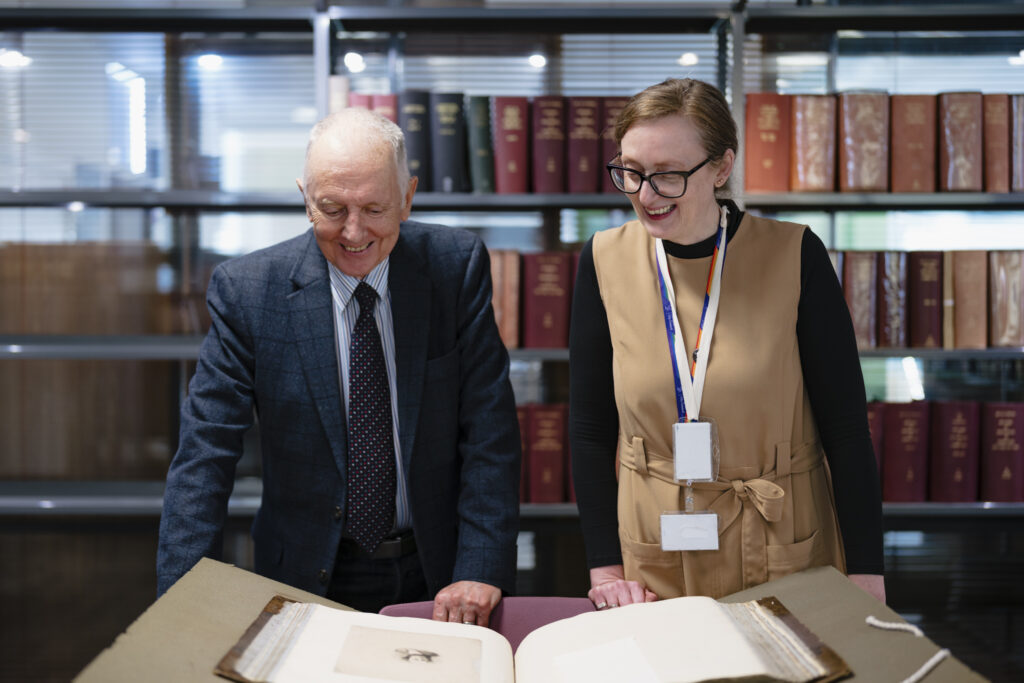Collection Encounter: Liverpool Record Office
Vicki Caren showing a price list for a Kosher butchers in the archive • Hidden Treasures/Drew Forsyth
On the third floor of the magnificent Victorian building that houses Liverpool’s Central Library, you can find the Liverpool Record Office (LRO), and this is where we met Vicki Caren the interim team leader of LRO. As we entered the modern Search Room, she told us more about the collections they hold.
This includes a wealth of history about Liverpool, about the city’s residents, about its growth and expansion and about the different communities who live there today, and those that helped found the city, including the Jewish community who have been present in Liverpool from the mid-eighteenth century onwards. ‘We hold material on the earliest Jewish organisation in Liverpool, there are registers here that document births, deaths and marriages in the community, deeds of assignment related to the ownership and transfer of land that would later have synagogues or burial grounds built there alongside reams of other material related to the long resident Jewish community of Liverpool.’

Photographs and archive material laid out in the reading room • Hidden Treasures/Drew Forsyth
Vicki had laid out a great range of ‘treasures’ from the LRO archives on a large table in the centre of the room for us to explore. ‘We’ve got many documents relating to prominent individuals,’ she said whilst directing us towards some items from the David Lewis collection. He had been a Jewish clothing manufacture, who opened his first shop in Liverpool in 1856, and became a prominent businessman in the city who is best known locally for Lewis’s department store.
This iconic building still stands in the city centre, although the previous iteration of this famous store was destroyed in the Blitz. ‘He was also a generous philanthropist who established hospitals and other institutions. The David Lewis Working Men’s Club and Home was established by bequest after his death,’ said Vicki, whilst pointing to an early twentieth century image of a massive brick building, ‘the footprint is quite imposing with those turrets in each corner. There was a theatre there, a restaurant, and healthcare facilities for the working poor. Sadly, the building doesn’t exist anymore. It was bombed during the Second World War.’ She showed us a small, printed book about David Lewis and his achievements from the collections, as well as black and white photographs of the interior of the hostel, and a rare 1895 edition of a printed pamphlet from the ‘one penny readings,’ events where people could hear a variety of poets and writers reading from their work for a penny.

Watercolour of Hope Place Synagogue • Hidden Treasures/Drew Forsyth
We moved around the table to look one of Vicki’s favourite items from the collection, a small lithograph dated 1864 by a local artist called W.G. Herdman, who had been a well-known watercolour artist from Liverpool. ‘This delicately coloured print accurately captures the attire of these middle-class Jewish ladies of this period, on their way to this synagogue in their elegant long dresses, holding their umbrellas, it is a wonderful snapshot of Jewish life in the city of that time,’ said Vicki. ‘The building on Hope Place still exists today but it is now the Unity Theatre.’
On the table nearby was a small faded blue booklet dated 1937, which contained the 89th annual report of the Jewish Ladies Benevolent Institution for the relief of poor women during sickness and confinement, which had been produced by the Merseyside Jewish Women’s Aid Society (established in Liverpool in 1849). This moving piece of ephemera told stories of how Jewish women have been supporting those in need and each other during childbirth, and times of difficulty in Liverpool for over a century. ‘There are many other records at LRO relating to the charitable activities of the organisations of Jewish women in Liverpool,’ said Vicki, ‘they include minute books from 1849-1979, annual reports 1937-2002, and by-laws of the Jewish Ladies Benevolent Institution.’

Drawing of Charles Mozley first Jewish mayor of Liverpool 1860s • Hidden Treasures/Drew Forsyth
As we continued to explore this fascinating material, John Cowell came into the reading room. John has been a regular visitor at LRO for the last four years, he is the former Chairman of the Liverpool branch of the Jewish Historical Society of England (JHSE), has written three books on different Jewish communities in the northwest and is now writing a new book about the Jewish community of Liverpool, so he comes to LRO to research every week. ‘It is a massive project,’ he said. ‘I hope I get to finish it in my lifetime. There are so many materials at LRO.’
The list of materials he has consulted at LRO so far include photographs and images of people and buildings; newspaper reports; local directories; annual reports and minute books of synagogues; the work of earlier historians going back to 1899; oral histories; title deeds and wills; historical maps and engravings of famous people. He showed me an engraving from the collections by the artist William Stubbs of a man called Charles Mozley, who had been the first Jewish mayor of Liverpool in the 1860s. ‘Unfortunately, he was also one of the leading members of Barned’s Bank, which suffered a collapse in 1866, and this man was partly responsible for that so he’s not looking so happy here!’
We were joined shortly afterwards by another regular visitor to LRO, Philip Sapiro, the Honorary Archivist of the Merseyside Jewish Representative Council. ‘There are over two hundred separate Jewish organisations in Liverpool who are represented in our archive,’ he said, ‘and some additional organisations and individuals who have their own subcategories in this archive which is held at LRO. There is a large collection of related books in the record office catalogue, and a list of other items of Jewish relevance in other sections of the archive such as pamphlets, newspaper articles and photographs for example. At the present time, the Jewish archive here consists of about 400 boxes – about 60 linear meters of documents if stacked up. There are a further 60 boxes awaiting cataloguing yet to be added to the total. We have collectively accumulated and gathered a vast amount of material over the years.’

John Cowell and Vicki Caren • Hidden Treasures/Drew Forsyth
Like John, Phil is passionate and extremely knowledgeable about the Liverpool Jewish community, ‘it was the first Jewish community in the north, and it dates back to the 1740s so there’s material stretching all the way back to that time, there’s so much here, from records on welfare to philanthropic organisations, to synagogue records, deeds, businesses, all sorts of social groups, even records from the Jewish Bread and Flour Committee!’
He showed me one of his ‘treasures’ from the collection, a rare eighteenth-century manuscript, which consisted of two gigantic sheets of ancient parchment covered in beautiful handwriting. ‘These historic documents summarise various agreements that were put in place for the founding of the Upper Frederick Street Synagogue,’ he said whilst pointing to the fading tightly written script. ‘They tell the story of a large parcel of land being transferred from the Earl of Derby to various people in the 1760s and then within this text it describes land being purchased earlier as a burial ground in 1773 and how a plot in front of the burial ground was purchased by the Jewish community in 1778, on which they the synagogue had been built. It is the third synagogue that the Liverpool community had adjoining the second oldest Jewish burial ground in Liverpool.’

Vicki Caren showing a price list for a Kosher butchers in the archive • Hidden Treasures/Drew Forsyth
LRO have four floors of archives stores located in the original library building, ‘which we refer to as the repository,’ said Vicki. In the temperature and humidity-controlled repository she shared another wonderful item from the Jewish collections, a poster dated 1940 produced by the Liverpool Hebrew Master Butchers Association, which relayed a maximum retail price list for Kosher meat. ‘The Liverpool Hebrew Master Butchers Association was founded in the early 1930s,’ said Vicki. ‘Regular meetings were not generally held but the Association brought together the kosher butchers in Liverpool, often to consider different aspects of business or to resolve disputes. As the number of kosher butchers on Merseyside declined the Association became unnecessary and closed operations.’
It was wonderful to encounter such an incredible range of material in our short visit. I asked Vicki if people had to be a member to come and research there and if LRO were still collecting new material. ‘The LRO is a local authority archive, a council-run organisation,’ she replied, ‘so anyone can come here and research. The only thing we ask is for people to book in advance and if anyone finds any material at home, with relatives or in the attic that relates to the Liverpool Jewish community past or present, please do let us know, we would love to keep it here as part of our collections.’